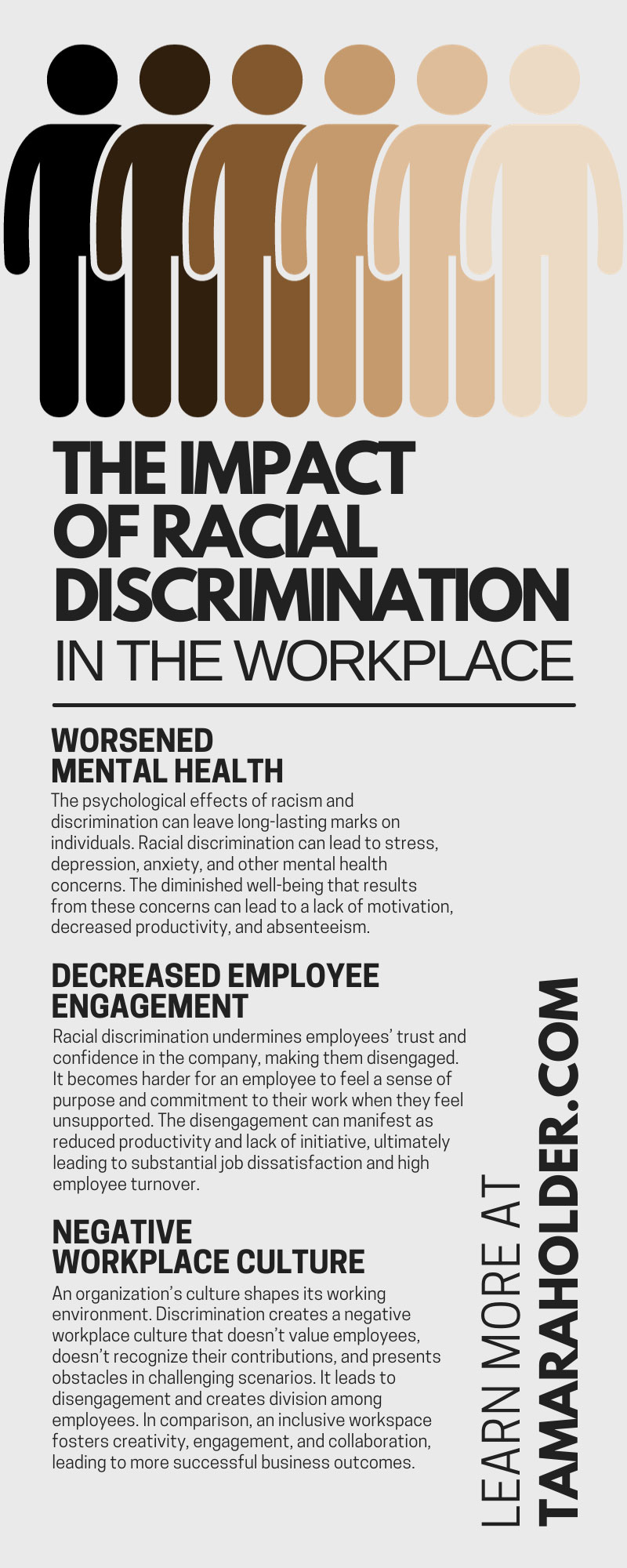Racial discrimination in the workplace is an issue you can’t ignore, as it affects whole organizations, from their employees’ morale to their business’s profitability. It is an employer’s responsibility to create a more inclusive workspace to mitigate the impacts of racial discrimination. Let’s discuss the impact of racial discrimination in the workplace, examples of racial discrimination, and what employers can do to take steps toward a more equality-focused workplace.
According to the Equal Employment Opportunity Commission (EEOC), racial discrimination occurs when an employer treats an employee or job applicant unfairly because of their race or ethnicity. This can include everything from hiring or promoting based on race to paying certain employees less than others based on their race.
The psychological effects of racism and discrimination can leave long-lasting marks on individuals. Racial discrimination can lead to stress, depression, anxiety, and other mental health concerns. The diminished well-being that results from these concerns can lead to a lack of motivation, decreased productivity, and absenteeism.
Racial discrimination undermines employees’ trust and confidence in the company, making them disengaged. It becomes harder for an employee to feel a sense of purpose and commitment to their work when they feel unsupported. The disengagement can manifest as reduced productivity and lack of initiative, ultimately leading to substantial job dissatisfaction and high employee turnover.
An organization’s culture shapes its working environment. Discrimination creates a negative workplace culture that doesn’t value employees, doesn’t recognize their contributions, and presents obstacles in challenging scenarios. It leads to disengagement and creates division among employees. In comparison, an inclusive workspace fosters creativity, engagement, and collaboration, leading to more successful business outcomes.
The negative effects of racial discrimination can exhaust talented employees, leading to high employee turnover and, consequently, higher recruitment and retraining costs. Unsatisfied employees will leave their jobs to seek alternative employment opportunities, and employers will struggle to recover the talent, skills, and experience of the employees they lose. The more diverse and racially inclusive the workplace is, the more a business can thrive.
Systemic racism often excludes people of color (POC) from job opportunities. The problem usually occurs in the hiring process, in which HR might subconsciously exclude candidates based on their racial backgrounds. Employers need to ensure their hiring process is inclusive and fair to all candidates. Make sure hiring processes are as free of racial bias as possible by using inclusive language and hiring recruiters who focus on diversity.
A microaggression is a subtle behavior or statement that denigrates a person—typically someone belonging to a marginalized group. People commit microaggressions often in good faith, meaning the person making the comment isn’t always aware of the message it conveys. Common examples include making assumptions based on stereotypes or saying things like, “You’re so articulate,” as if it were unusual for a person of a particular race to be well-spoken. Employers need to affirmatively foster environments in which people feel comfortable speaking up about microaggressions and other types of racial discrimination.
Racially biased employers may overlook their minority employees’ promotion aspects compared with their white peers. This happens even when minority employees have the necessary qualifications and experience. By looking strictly at employees’ duties, experience, skills, and educational backgrounds, employers can help weed out racial bias. Companies should emphasize diversity, equity, and inclusion to create an environment where anyone can progress in their career.
The first step in creating a racially inclusive workplace is to provide diversity and inclusion training to all employees. This should be an ongoing process rather than a one-time event. Employees should receive training on issues of racism, privilege, stereotypes, and unconscious bias, among others. This education helps create a common language and understanding around issues of race and diversity.
A diverse workforce is essential in creating a racially inclusive workplace. Employers should seek to recruit people from different backgrounds and experiences. This means creating job postings that specifically target diverse candidates. Employers should also provide the necessary support and resources to retain diverse employees.
To diversify the workforce, employers should consider implementing a diversity hiring program that attracts applicants from different backgrounds. Try to remove any barriers that may deter qualified candidates from applying, such as racially coded job descriptions. By creating a diverse workforce, you bring new perspectives, experiences, and ideas to the table, ultimately benefiting your company and its growth.
Discrimination and biases are unfortunately pervasive in many workplaces. It is an employer’s responsibility to address these issues promptly and appropriately. Encourage employees to report discriminatory behavior by giving them a safe space to address their concerns, and take the necessary measures to address the issue. Also, implementing regular diversity training for employees and management could be an effective way to address and prevent discriminatory practices.
Finally, fostering open communication channels between employees and management can help create a racially inclusive workplace. Encouraging employees to share their experiences and perspectives can help promote understanding and create a sense of belonging. Regular employee feedback sessions and open forums can also help create a supportive, inclusive workspace.
Racial discrimination can impact the workplace in more ways than one, leading to numerous negative effects on individuals and the organization’s success. Employers must care for all staff, and part of that duty includes preventing discrimination in the workplace. Creating a more inclusive culture that values and respects diverse backgrounds and experiences can improve the health, satisfaction, and productivity of employees.
If you’re dealing with racial discrimination in the workplace or your employer isn’t doing what they should to stop racial discrimination, contact the Law Firm of Tamara N Holder today. Tamara Holder is a racial injustice lawyer with years of experience handling sensitive cases like yours and will do everything in her power to get you the compensation and resolution you deserve.
